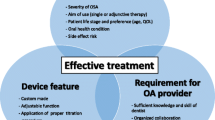Abstract
Study objectives
Oral appliance (OA) therapy is considered a first line choice of therapy for some patients with mild or moderate obstructive sleep apnea (OSA) and an alternative form of treatment in those intolerant of continuous positive airway pressure (CPAP) use. According to several studies, periodic limb movements (PLM) appear during effective treatment of OSA with CPAP, but a similar phenomenon has not been described with the use of oral appliance. Herein, we describe the incidence of PLM in patients with OSA who underwent oral appliance therapy titration.
Design
This is a prospective, observational study set in a six-bed sleep center in an academic, military referral hospital.
Patients and methods
Patients with OSA (n = 21; 15 men and six women; mean age, 43 years; and age range, 25 to 53 years) treated with OA during a 1-year period were enrolled. Patients were categorized according to the severity of sleep apnea and incidence of PLM on diagnostic polysomnography. Effective treatment of OSA and appearance or disappearance of PLM with arousal on subsequent oral appliance titration polysomnography were recorded and compared.
Results
Twenty-one patients were enrolled. During baseline polysomnography, three of 21 (14%) patients had five or more PLM with arousal per hour while 11 of 21 (52%) patients had PLM with arousal during the oral appliance titration trial.
Conclusion
Oral appliance therapy for obstructive sleep apnea is an effective treatment and ideal for use in military recruits. The appearance of periodic limb movements with arousal during oral appliance use should be considered as a cause of persistent daytime sleepiness despite effective treatment of obstructive sleep apnea in this subset of patients.


Similar content being viewed by others
Abbreviations
- EDS:
-
Excessive daytime sleepiness
- OSA:
-
Obstructive sleep apnea
- AHI:
-
Apnea hypopnea index
- PLM:
-
Periodic limb movement
- PLMD:
-
Periodic limb movement disorder
- OA:
-
Oral appliance
- EEG:
-
Electroencephalogram
- CPAP:
-
Continuous positive airway pressure
- MSLT:
-
Multiple sleep latency testing
- ESS:
-
Epworth Sleepiness Scale
References
Hornyak M, Feige B, Riemann D, Voderholzer U (2006) Periodic leg movements in sleep and periodic limb movement disorder: prevalence, clinical significance and treatment. Sleep Med Rev 10(3):169–177
Scofield H, Roth T, Drake C (2008) Periodic limb movements during sleep: population prevalence, clinical correlates, and racial differences. Sleep 31(9):1221–1227
McCall WV, Haponik E (1993) Relationship of nasal continuous positive airway pressure to periodic limb movement disorder in a patient without sleep apnea. Chest 103(5):1609–1611
Briellmann RS, Mathis J, Bassetti C, Gugger M, Hess CW (1997) Patterns of muscle activity in legs in sleep apnea patients before and during nCPAP therapy. Eur Neurol 38(2):113–118
Carelli G, Krieger J, Calvi-Gries F, Macher JP (1999) Periodic limb movements and obstructive sleep apneas before and after continuous positive airway pressure treatment. J Sleep Res 8(3):211–216
Baran AS, Richert AC, Douglass AB, May W, Ansarin K (2003) Change in periodic limb movement index during treatment of obstructive sleep apnea with continuous positive airway pressure. Sleep 26(6):717–720
Fry JM, DiPhillipo MA, Pressman MR (1989) Periodic leg movements in sleep following treatment of obstructive sleep apnea with nasal continuous positive airway pressure. CHEST 96:89–91
Yamashiro Y, Kryger MH (1994) Acute effect of nasal CPAP on periodic limb movements associated with breathing disorders during sleep. Sleep 17(2):172–175
Schmidt-Nowara W, Lowe A, Wiegand L (1995) Practice parameters for the treatment of snoring and obstructive sleep apnea with oral appliances. Sleep 18:511–513
Kushida CA, Morgenthaler TI, Littner MR (2006) Practice parameters for the treatment of snoring and obstructive sleep apnea with oral appliances: an update for 2005. Sleep 29:240–243
Ferguson KA, Cartwright R, Rogers R (2006) Oral appliances for snoring and obstructive sleep apnea: a review. Sleep 29:244–262
Center for Devices and Radiologic Health (2002) Class II special controls guidance document: intraoral devices for snoring and/or obstructive sleep apnea: guidance for industry and FDA. Rockville, MD: US Food and Drug Administration
Haba-Rubio J, Staner L, Krieger J, Macher JP (2005) Periodic limb movements and sleepiness in obstructive sleep apnea patients. Sleep Med 6(3):225–229
Al-Alawi, Mulgrew A, Tench E, Ryan CF (2006) Prevalence, risk factors and impact on daytime sleepiness and hypertension of periodic leg movements with arousals in patients with obstructive sleep apnea. J Clin Sleep Med 2(3):281–287
Guilleminault C, Lopes C, Hagen CC (2007) The cyclic alternating pattern demonstrates increased sleep instability and correlates with fatigue and sleepiness in adults with upper airway resistance syndrome. Sleep 30:641–647
Guilleminault C, Stoohs R, Clerk A (1992) From obstructive sleep apnea syndrome to upper airway resistance syndrome: consistency of daytime sleepiness. Sleep 15:S13–S16
Kristo DA, Lettieri CJ, Andrada T (2005) Silent upper airway resistance syndrome: prevalence in a mixed military population. CHEST 127(5):1654–1657
Chervin RD (2001) Periodic leg movements and sleepiness in patients evaluated for sleep-disordered breathing. Am J Respir Crit Care Med 164(8):1454–1458
Krishnan V, Collop NA, Scherr SC (2008) An evaluation of a titration strategy for prescription of oral appliances for obstructive sleep apnea. CHEST 133:1135–1141
Saletu A, Anderer P, Parapatics S (2007) Effects of mandibular repositioning appliance on sleep structure, morning behavior and clinical symptomatology in patients with snoring and sleep-disordered breathing. Neuropsychobiology 55:184–193
Author information
Authors and Affiliations
Corresponding author
Additional information
This was not an industry supported study. The authors have no financial conflicts of interest.
An erratum to this article can be found at http://dx.doi.org/10.1007/s11325-010-0401-0
Rights and permissions
About this article
Cite this article
Guerrero, M.L., Kim, D., Rupp, T.L. et al. Oral appliance titration in patients with obstructive sleep apnea induces the appearance of periodic limb movements. Sleep Breath 14, 359–363 (2010). https://doi.org/10.1007/s11325-009-0321-z
Received:
Revised:
Accepted:
Published:
Issue Date:
DOI: https://doi.org/10.1007/s11325-009-0321-z




